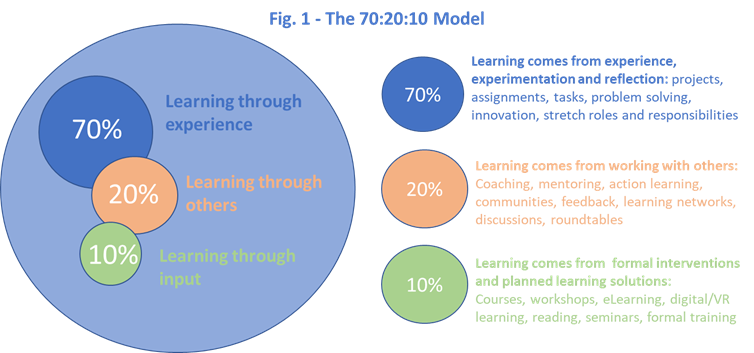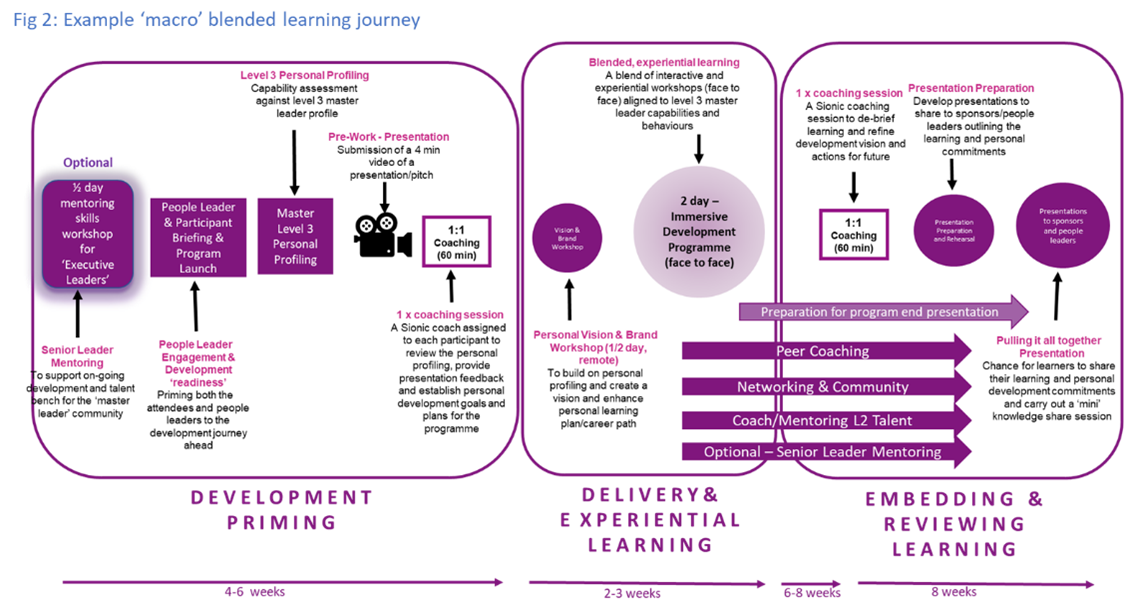As specialists in learning and development, we always want our development programmes to be successful and to demonstrate real value to both the participants and their organisation, with a clear return on investment. Its important to us that our learners are able to apply their new skills, behaviours and mindsets back in the workplace to enhance their own and the business’ performance.
In order to achieve this, we leverage the 70:20:10 model illustrated below in our programme design. This is a well-known, proven framework that demonstrates how individuals learn and expand their capability in practice. We apply this model at both a ‘macro’ and ‘micro’ level, therefore doubling the opportunity for the learning to ‘stick’.
The 70:20:10 model outlines the percentage of impact the learning method has on a participant, meaning 70% of learning occurs from an experience through to 10% of learning occurring through formal input. As you may have noticed, I have deliberately avoided using the term ‘training’, because formal training sits within the 10% ‘learning through input’ part of the model, and should be viewed as just one element of the learning proposition for participants to truly make an impact on growth, skills, knowledge, behaviour and mindset change.

What’s meant by a ‘macro’ and ‘micro’ level approach to the 70:20:10 model?
As we begin to design a development programme, we initially look at the ‘macro’ level below, thinking about the whole journey of learning, ensuring we have multiple blends of facilitator led input, self-directed learning, coach/mentoring and or action learning groups along with real life business projects, presentations, or case studies. This provides full coverage of the 70:20:10 model over a period of time, giving the learner the space and opportunity to experience, reflect and apply the development, practicing and refining in a continuous cycle.

We then seek to apply this approach on a ‘micro’ level (Fig 3) during the immersive development phase of the learning journey during each module/workshop – and often within each facilitator led learning session.
To achieve this, we typically phase the learning proposition in three key stages:
Stage 1 – ‘Development Priming’
We want to set learners up for success and we strongly recommend an initial period of time to prime participants for the development journey ahead, particularly if it’s a significant programme extending over six months.
- What is ‘development priming’?
Basically, it’s about ensuring the participants fully understand their development needs and why they have been invited to participate in a learning programme. It gives the individual the opportunity to determine if it’s the right time to participate in a lengthy development programme and/or start to think about their learning goals, understand the commitments required for the terrain ahead, and perhaps complete self-reflection assessments or psychometrics in preparation.
It also enables people leaders to be fully engaged and on-board to provide continuous support and create space, feedback, and opportunities to practice and embed the learning.
By having this initial period of development priming, it sets the individual up for success, reassures them they have the support and time to focus on their learning, giving them greater confidence at the beginning and throughout their learning journey. It also helps organisations create a stronger ‘learning culture’, demonstrating the importance of developing others, often leading to employee retention, attraction, organisation reputation and brand.
Stage 2 – Immersive Development
We want our learners to have a great development experience; something that really appeals to their own preferred learning styles, sharing great models, practical tools and concepts through facilitator led input sessions, having the opportunity to test them out and experiment in a safe learning environment. This is what we call ‘immersive development’, which we deliver through a range of face to face or remote modules, depending on the client’s needs or the learners’ geographic locations. During these sessions, we leverage the micro level 70:20:10 blended learning model by a range of facilitated learning input (10%), give participants the opportunity to learn through others (20%) through group, peer discussions, action learning and reflection and then participate in experiential learning activities leveraging cases studies, practical exercises or scenarios to help bring the learning to life (70%).
Stage 3 – Embedding and Review
This is the final stage of the macro application of the blended learning model and has many benefits, in particular the embedding of learning back into the workplace, forming new ways of working and behaviours, resulting in a shift forward, growth and enhanced performance.
How often have you decided on a New Year resolution to eat less or exercise more and then find you have reverted to your normal habits less than two weeks later? This is because adopting new ways of operating, changing behaviours and mindsets is really challenging and takes continued practice, application, and review to truly make it stick.
We recommend a blend of activities within this stage:
- 121 coaching (four – six months) enabling learners to focus on their personal learning goals in a confidential and personal environment, identifying their own actions and activities to address their challenges, encouraging individuals to take more responsibility for their learning, stretching their current capability and ultimately enhancing their own and business performance.
- Peer coaching and or action learning groups, not only enhancing the development of the learners, but also continuing to enhance workplace relationships, breakdown functional barriers and creating communities of professionals who can engage with each other, share best practice, resolve business challenges collectively and create a continuous learning journey.
- Mentoring, where appropriate we would recommend leaders and or technical experts are developed as mentors to be formally allocated to learners over a period of time, to share their experiences, be a sounding board and support the learner in their growth. This can help build confidence, retain, and transfer knowledge in the business and demonstrate a commitment to the on-going development of future talent and or employee capability.
- Formal presentations and playback are encouraged as they give multiple benefits to both the organisation and the learners. It can be an opportunity for learners to formally present and showcase their findings and outputs from a project or case study to the senior sponsors and stakeholders. This both tests their ability to present, engage others and share information as well as sharing what they have learnt from the overall development programme and how they are going to apply it back into the workplace. This enables the sponsors to hear and see how the learners have grown during the programme, look to invest further in the project/s or case studies often leading to tangible business benefits as well as an opportunity to give recognition to the participants.
In short, our secret is simple: set participants up for success by development priming and providing a blended learning development experience that enables deeper capability, behaviour and mindset growth for your people and organisation.
If you’d like to find out more about our approach, or about any of our programmes, please contact us.



